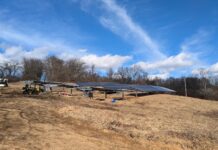Over the weekend, my daughter and I walked through the backyard to check out all of our projects from within the last year. Our potato patch is planted and, hopefully, improved for better yields this year. Our fruit trees are pruned and are already starting to leaf out. Even the leaves on our blueberry bushes are starting to unfold.
With everything looking so healthy, it’s a perfect time to start our next project. We’re thinking raspberry bushes this time.
Pre-planting considerations
When they are given proper growing conditions and care raspberry bushes can have prolific yields. Raspberries thrive on sunny sites with well-drained soil. Gardeners in USDA hardiness zones 3 to 10 can grow raspberries successfully by choosing the right variety.
Soil. As with any plant, the right soil conditions are imperative to successful establishment and growth. Raspberries prefer rich, well-drained soil with a pH between 6.0 and 6.5. Avoid soil that contains large amounts of clay and less than 2% organic matter content. If your soil isn’t ideal, you can dig a hole twice as wide and deep as the roots and create a 50:50 blend with the soil you removed and in-ground garden soil to ensure there are enough nutrients to support your bush. Nitrogen should be applied to soil annually to maintain production.
Location. The location you choose should be sunny, offering at least 6-8 hours of full sun a day. It should also feature well-drained soil with sloped sites being no more than 12% sloped. Water running off a slope doesn’t necessarily ensure good drainage. Additionally, raspberries require space and support to grow and produce well. Don’t plant them in your garden with other plants. It’s best to grow them in a row on the edge of your yard where they can be supported by a trellis.
Choosing a variety. Choosing the right variety for your growing zone and needs is crucial. Some plants have shorter growing seasons and different varieties bear fruit at different times of the growing season. Penn State Extension and Ohio State University have detailed recommendations for Ohio and Pennsylvania, respectively.
- Penn State Extension, Recommended Raspberry Varieties for Pennsylvania
- Ohio State University, Raspberries
Pollination. Raspberries self-pollinate, so you don’t need to worry about planting different varieties to cross-pollinate.
Planting
Bareroot raspberry plants should be planted 3-4 feet apart during late spring. Follow these steps to successfully establish your raspberry bushes:
- Soak roots in lukewarm water for an hour before planting.
- Dig a hole twice as wide and lust as deep for the roots.
- Mix the soil you set aside with in-ground garden soil to create a 50:50 in-ground garden soil.
- Mound this soil in the hole and spread the roots out on the mound.
- Backfill around the roots and tamp down the soil so that it is even with the ground surrounding the hole.
- Cut stems back to 3 inches above the soil line to encourage new growth beneath the soil and help your raspberry bushes get established.
- Apply 2-3 inches of clean straw or mulch around each plant to keep the soil evenly moist throughout the growing season.
- Water plants thoroughly after planting and keep them evenly watered during summer. Whenever the top inch of soil is dry, they should be watered. Drip irrigation and soaker hose systems work well to maintain moisture.
Support. Raspberry bushes require a sturdy support system for optimal growth and better yields. You can set up a simple trellis with T-posts and wire.
Each Post should have two cross arms — one in the middle and one at the top — with the lowest at a height of about 3-4 feet. Posts should be placed every 5-8 feet along your row of raspberry bushes. Once posts are in place, run wire between the crossbars to connect them.
















